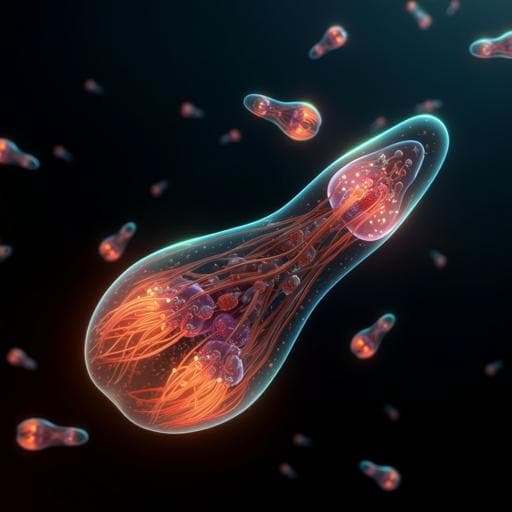
Engineering and Technology
Self-sensing intelligent microrobots for noninvasive and wireless monitoring systems
Z. Li, K. Wang, et al.
Discover the groundbreaking self-sensing AI microrobot developed by Zhongyi Li, Kun Wang, Chaojian Hou, Chunyang Li, Fanqing Zhang, Wu Ren, Lixin Dong, and Jing Zhao. This innovative technology facilitates wireless, real-time environmental interaction and holds immense potential for minimally invasive in vivo monitoring, especially in disease locations, allowing for early diagnosis.
~3 min • Beginner • English
Introduction
Microrobots have attracted considerable attention for various biomedical applications in the near future. Their small size and flexible movement allow minimally invasive or essentially noninvasive travel through narrow and complex areas for in situ diagnosis and treatment, including targeted drug delivery. Functional microrobotic systems require perception, cognition, action, control, and higher-level intelligence. Prior research has emphasized precise motion control relying on external global visual feedback and control, while embedding self-perception into microrobots remains challenging yet valuable for local diagnosis in precision medicine. Because biomarker concentrations are often elevated near diseased tissues compared to diluted blood and other fluids, self-sensing microrobots can be deployed noninvasively to target locations for early disease diagnosis, patrol to detect abnormalities, and enable in situ disease mapping and continuous monitoring of microenvironmental changes. Fluorescence sensing offers high resolution and has been combined with microrobots, but single-photon excitation (ultraviolet) has a tissue penetration depth <0.5 mm and multiphoton excitation (near-infrared) achieves <1.5–2 mm, motivating new sensing methods for in vivo perception and real-time readout.
In this work, the authors propose a wireless self-sensing AI microrobot based on local magnetic field enhancement in electromagnetic imaging for noninvasive in vivo monitoring. The microrobot features a head with a thin-film sensor acting as a tunable RF coil and a magnetic tail driven by an external magnetic field. The sensor is an inductor-capacitor circuit connected via through holes, enabling local signal enhancement in electromagnetic imaging and wireless transmission without onboard power. Sensor circuit geometry determines working ranges via resonance frequency, which is influenced by the environment. Increasing the size and number of interdigital electrode pairs increases capacitance and lowers the resonant frequency. Increased environmental conductivity raises circuit resistance and reduces local RF field enhancement. Environmental variables such as pH and temperature alter conductivity and permittivity, respectively, enabling real-time monitoring: lower pH increases conductivity; higher temperature lowers permittivity. When the sensor resonance is tuned to the imaging device operating frequency, the microrobot appears as a bright spot in the image. This approach leverages existing electromagnetic imaging equipment to realize passive wireless sensing with simplified, miniaturized sensor structures.
Literature Review
Methodology
Device architecture and actuation: The microrobot consists of a head platform carrying a passive thin-film RLC sensor and a magnetic helical tail for magnetic-field-driven locomotion. The head hosts an external loop (coil) and interdigital electrodes forming a tunable inductor-capacitor sensor that modulates the local RF magnetic field of an external imaging system (e.g., MRI).
Fabrication process: (1) Begin with a Si substrate covered with 300 nm SiO2; deposit a 300 nm Al2O3 sacrificial layer. (2) Fabricate a double-layer tail including preprocessed Si3N4 and a prestressed SiNx membrane to enable 3D rolling-up. The precompressive Si3N4 generates opposing forces at the release interface, providing a bending moment. Upon isotropic release of an initial parallelogram mesh, the structure rolls into a helical tail, with final geometry determined by release shape, driving force, and film stiffness. (3) Form the head platform from 100 nm SiO2 to support the sensor. (4) Sequentially fabricate the three-layer sensor on the head: an annular outer electrode coil connected via two through-holes to a bottom electrode, and a middle region of interdigital electrodes (<10 interdigitates occupying ~25% of head area) that provide the sensing capacitance and resistance. RF coil sizes range from ~500 to ~50 μm; the number of interdigital pairs is adjustable. (5) Release the device by soaking the chip in NaOH to etch Al2O3; the Si3N4 stress is released, rolling the tail into a helix.
Passive RLC sensing principle: The imaging system’s RF transmit coil generates a magnetic field that induces current in the microrobot’s external loop (inductor Ls), driving the sensor circuit comprising Ls in series with environmental dependent Rs and Cs from the interdigital electrodes. Due to weak coupling (small coupling coefficient) and large distance to the drive coil, the drive field and induced sensor coil voltage can be considered constant; sensor current is governed by its impedance. At resonance, current and local RF field enhancement are maximized. Resonance frequency fs = 1/(2π√(LsCs)); quality factor Qs = (1/Rs)√(Ls/Cs). Environmental effects: The interdigital electrodes couple to the surrounding solution and substrate; equivalent resistance Rf and capacitance Cf through the solution, and substrate capacitance Csub, define the net CIDE and Rf, thus effective Rs and Cs. Increased environmental conductivity raises Rs (loss) and reduces the enhancement; increased permittivity raises Cs, lowering fs. pH modulates conductivity (lower pH → higher conductivity), and temperature modulates permittivity (higher temperature → lower permittivity).
Operation with imaging: When the sensor resonance is tuned to the operating frequency of the electromagnetic imaging equipment, the local RF magnetic field is enhanced at the microrobot location, producing a bright spot in images. The imaging signal strength relates to sin(α), with α the flip angle affected by local RF field strength.
Simulation: Using a high-frequency structure simulator (HFSS), the interdigital electrode characteristics were modeled for a microrobot head size of 500 μm with 11 interdigital pairs over 0.5–2 GHz. Real and imaginary impedance magnitudes decrease with frequency; increasing environmental conductivity increases the real part and decreases the imaginary part, consistent with the analytical model.
Key Findings
- A self-sensing AI microrobot was demonstrated that wirelessly harvests energy from external electromagnetic imaging RF fields and enhances the local RF magnetic field for deep, high-resolution in situ sensing.
- The microrobot requires no onboard power and can be magnetically actuated via a helical tail for precise motion control and positioning in complex in vivo environments, enabling near-noninvasive monitoring around potential disease sites.
- Sensor working ranges are set by the RLC circuit design; increasing interdigital electrode size/pairs increases capacitance and lowers resonance frequency, enabling tunability to match imaging system frequencies.
- Environmental parameters modulate sensor response: higher conductivity (e.g., lower pH) increases losses (Rs) and reduces enhancement; changes in permittivity (e.g., with temperature) shift resonance frequency (Cs), enabling real-time monitoring of biochemical parameters such as pH and temperature.
- Maximum reported local RF magnetic field enhancement is approximately 560-fold at resonance under favorable conditions.
- When tuned to the imaging frequency, the microrobot appears as a bright spot in electromagnetic imaging, facilitating real-time localization and readout.
- The fabrication process is compatible with batch production, enabling swarms of functional microrobots.
Discussion
The work addresses the challenge of embedding self-perception into microrobots by integrating a passive, wirelessly powered RLC sensor that interacts with existing electromagnetic imaging systems. By enhancing the local RF magnetic field at resonance, the microrobot enables deep-penetrating, high-spatial-resolution sensing, overcoming the limited tissue penetration of fluorescence-based methods. The demonstrated tunability of the sensor through geometry (electrode count/size) and environmental coupling (conductivity, permittivity) allows the device to sense and report local biochemical changes such as pH and temperature in real time. Magnetic actuation of the helical tail provides precise, external control of microrobot positioning, enabling targeted in situ monitoring and potential disease mapping. These capabilities suggest utility for early disease detection, precision diagnostics, and future therapeutic guidance while leveraging widely available imaging modalities like MRI for wireless power and readout.
Conclusion
This study introduces a passive, wirelessly self-sensing AI microrobot that couples to electromagnetic imaging fields to enhance local RF signals for deep, high-resolution in situ sensing without onboard power. The microrobot integrates a tunable thin-film RLC sensor on a microfabricated head with a magnetically actuated helical tail, enabling precise motion and targeted monitoring. The sensor’s resonance can be engineered through geometry and is sensitive to environmental conductivity and permittivity, allowing real-time monitoring of parameters like pH and temperature. Reported enhancement of the local RF magnetic field reaches ~560×, and bright-spot imaging confirms on-resonance detection. A compatible fabrication process supports batch production and potential swarms for broader coverage. Future work could optimize sensor Q-factor and resonance matching in physiological environments, expand target analytes, integrate biocompatible coatings and functionalization, and validate performance in vivo with clinical imaging systems.
Limitations
- Reliance on resonance matching: The sensing enhancement is maximized only when the sensor resonance aligns with the imaging system frequency; detuning from environmental changes may reduce signal.
- Environmental conductivity effects: Increased conductivity raises losses (Rs), diminishing local RF field enhancement and potentially limiting performance in highly conductive media.
- Weak coupling to the drive coil: The coupling coefficient is small; although acceptable for local enhancement, it limits back-action and may constrain remote excitation efficiency.
- The text does not provide in vivo validation results, quantitative imaging SNR gains across biological tissues, or long-term biocompatibility and safety assessments.
- Specific institutional affiliations and detailed experimental datasets are not provided in the excerpt, and broader generalizability requires further testing in physiological conditions.
Related Publications
Explore these studies to deepen your understanding of the subject.







